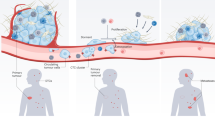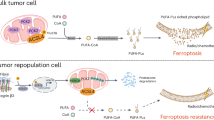Abstract
The interactions between cancer cells and their microenvironment are crucial for malignant progression, as they modulate invasion-related activities. Tumor-associated macrophages are generally considered allies in the process of tumor progression in several types of cancer, although their role on gastric and colorectal carcinomas is still poorly understood. In this report, we studied the influence of primary human macrophages on gastric and colorectal cancer cells, considering invasion, motility/migration, proteolysis and activated intracellular signaling pathways. We demonstrated that macrophages stimulate cancer cell invasion, motility and migration, and that these effects depend on matrix metalloproteinase (MMP) activity and on the activation of epidermal growth factor receptor (EGFR) (at the residue Y1086), PLC-γ (phospholipase C-gamma) and Gab1 (GRB2-associated binding protein-1), as evidenced by siRNA (small interference RNA) experiments. Epidermal growth factor (EGF)-immunodepletion impaired macrophage-mediated cancer cell invasion and motility, suggesting that EGF is the pro-invasive and pro-motile factor produced by macrophages. Macrophages also induced gastric and colorectal cancer cell phosphorylation of Akt, c-Src and ERK1/2, and led to an increase of RhoA and Cdc42 activity. Interestingly, whereas macrophage-mediated cancer cell c-Src and ERK1/2 phosphorylation occurred downstream EGFR activation, Akt phosphorylation seems to be a parallel event, taking place in an EGFR-independent manner. The involvement of EGF, EGFR-downstream signaling partners and MMPs in macrophage-mediated invasion provides novel insights into the molecular crosstalk established between cancer cells and macrophages, opening new perspectives for the design of new and more efficient therapeutic strategies to counteract cancer cell invasion.
This is a preview of subscription content, access via your institution
Access options
Subscribe to this journal
Receive 50 print issues and online access
$259.00 per year
only $5.18 per issue
Buy this article
- Purchase on Springer Link
- Instant access to full article PDF
Prices may be subject to local taxes which are calculated during checkout








Similar content being viewed by others
References
Coussens LM, Werb Z . Inflammation and cancer. Nature 2002; 420: 860–867.
De Wever O, Mareel M . Role of tissue stroma in cancer cell invasion. J Pathol 2003; 200: 429–447.
Joyce JA, Pollard JW . Microenvironmental regulation of metastasis. Nat Rev Cancer 2009; 9: 239–252.
Liotta L, Khon EC . The microenvironment of the tumor–host interface. Nature 2001; 411: 375–379.
Allen M, Louise Jones J . Jekyll and Hyde: the role of the microenvironment on the progression of cancer. J Pathol 2011; 223: 162–176.
Oliveira MJ, Damme JV, Lauwaet T, Corte VD, Bruyne GD, Verschraegen G et al. Beta-casein-derived peptides, produced by bacteria, stimulate cancer cell invasion and motility. EMBO J 2003; 22: 6161–6173.
Oliveira MJ, Costa AC, Costa AM, Henriques L, Suriano G, Atherton JC et al. Helicobacter pylori induces gastric epithelial cell invasion in a c-Met and Type IV secretion system-dependent manner. J Biol Chem 2006; 281: 34888–34896.
Hagemann T, Balkwill F, Lawrence T . Inflammation and cancer: a double-edged sword. Cancer Cell 2007; 12: 300–301.
Mantovani A, Allavena P, Sica A, Balkwill F . Cancer-related inflammation. Nature 2008; 454: 436–444.
Grivennikov SI, Greten FR, Karin M . Immunity, inflammation, and cancer. Cell 2010; 140: 883–899.
Coffelt SB, Hughes R, Lewis CE . Tumor-associated macrophages: effectors of angiogenesis and tumor progression. Biochim Biophys Acta 2009; 1796: 11–18.
Ohno SI, Inagawa H, Dhar DK, Fujii T, Ueda S, Tachibana M et al. The degree of macrophage infiltration into the cancer cell nest is a significant predictor of survival in gastric cancer patients. Anticancer Res 2003; 23: 5015–5022.
Leek RD, Lewis CE, Whitehouse R, Greenall M, Clarke J, Harris AL . Association of macrophage infiltration with angiogenesis and prognosis in invasive breast carcinoma. Cancer Res 1996; 56: 4625–4629.
Condeelis J, Pollard JW . Macrophages: obligate partners for tumor cell migration, invasion, and metastasis. Cell 2006; 124: 263–266.
Lin EY, Gouon-Evans V, Nguyen AV, Pollard JW . The macrophage growth factor CSF-1 in mammary gland development and tumor progression. J Mam Gland Biol Neopl 2002; 7: 147–162.
Wyckoff J, Wang W, Lin EY, Wang Y, Pixley F, Stanley ER et al. A paracrine loop between tumor cells and macrophages is required for tumor cell migration in mammary tumors. Cancer Res 2004; 64: 7022–7029.
Lin EY, Nguyen AV, Russell RG, Pollard JW . Colony-stimulating factor 1 promotes progression of mammary tumors to malignancy. J Exp Med 2001; 193: 727–740.
Goswami S, Sahai E, Wyckoff JB, Cammer M, Cox D, Pixley FJ et al. Macrophages promote the invasion of breast carcinoma cells via a colony-stimulating factor-1/epidermal growth factor paracrine loop. Cancer Res 2005; 65: 5278–5283.
Wang W, Goswami S, Sahai E, Wyckoff JB, Segall JE, Condeelis JS . Tumor cells caught in the act of invading: their strategy for enhanced cell motility. Trends Cell Biol 2005; 15: 138–145.
Forssell J, Oberg A, Henriksson ML, Stenling R, Jung A, Palmqvist R . High macrophage infiltration along the tumor front correlates with improved survival in colon cancer. Clin Cancer Res 2007; 13: 1472–1479.
Hakansson L, Adell G, Boeryd B, Sjogren F, Sjodahl R . Infiltration of mononuclear inflammatory cells into primary colorectal carcinomas: an immunohistological analysis. Br J Cancer 1997; 75: 374–380.
Ohta M, Kitadai Y, Tanaka S, Yoshihara M, Yasui W, Mukaida N et al. Monocyte chemoattractant protein-1 expression correlates with macrophage infiltration and tumor vascularity in human gastric carcinomas. Int J Oncol 2003; 22: 773–778.
Ishigami S, Natsugoe S, Tokuda K, Nakajo A, Okumura H, Matsumoto M et al. Tumor-associated macrophage (TAM) infiltration in gastric cancer. Anticancer Res 2003; 23: 4079–4083.
Kang JC, Chen JS, Lee CH, Chang JJ, Shieh YS . Intratumoral macrophage counts correlate with tumor progression in colorectal cancer. J Surg Oncol 2010; 102: 242–248.
Kuroda T, Kitadai Y, Tanaka S, Yang X, Mukaida N, Yoshihara M et al. Monocyte Chemoattractant Protein-1 transfection induces angiogenesis and tumorigenesis of gastric carcinoma in nude mice via macrophage recruitment. Clinic Cancer Res 2005; 11: 7629–7636.
Oguma K, Oshima H, Aoki M, Uchio R, Naka K, Nakamura S et al. Activated macrophages promote Wnt signaling through tumor necrosis factor-alpha in gastric tumor cells. EMBO J 2008; 27: 1671–1681.
Oliveira MJ, Lauwaet T, De Bruyne G, Mareel M, Leroy A . Listeria monocytogenes produces a pro-invasive factor that signals via ErbB2/ErbB3 heterodimers. J Cancer Res Clin Oncol 2005; 131: 49–59.
Machesky LM . Lamellipodia and filopodia in metastasis and invasion. FEBS Letters 2008; 582: 2102–2111.
Patsialou A, Wyckoff J, Wang Y, Goswami S, Stanley ER, Condeelis JS . Invasion of human breast cancer cells in vivo requires both paracrine and autocrine loops involving the colony-stimulating factor-1 receptor. Cancer Res 2009; 69: 9498–9506.
Jones NP, Peak J, Brader S, Eccles SA, Katan M . PLC-gama1 is essential for early events in integrin signaling required for cell motility. J Cell Sci 2005; 118: 2695–2706.
Abella JV, Vaillancourt R, Frigault MM, Ponzo MG, Zuo D, Sangwan V et al. The Gab1 scaffold regulates RTK-dependent dorsal ruffle formation through the adaptor Nck. J Cell Sci 2010; 123: 1306–1319.
Hagemann T, Wilson J, Kulbe H, Li NF, Leinster DA, Charles K et al. Macrophages induce invasiveness of epithelial cancer cells via NF-kB and JNK. J Immunol 2005; 175: 1197–1205.
Pukrop T, Klemm F, Hagemann T, Gradl D, Schulz M, Siemes S et al. Wnt 5a signaling is critical for macrophage-induced invasion of breast cancer cell lines. Proc Natl Acad Sci USA 2006; 103: 5454–5459.
Green CE, Liu T, Montel V, Hsiao G, Lester RD, Subramaniam S et al. Chemoattractant signaling between tumor cells and macrophages regulates cancer cell migration, metastasis and neovascularization. PLoS One 2009; 4: e6713.
Coniglio SJ, Eugenin E, Dobrenis K, Stanley ER, West BL, Symons MH et al. Microglial stimulation of glioblastoma invasion involves EGFR and CSF-1R signaling. Mol Med 2012; 18: 519–527.
Liguori M, Solinas G, Germano G, Mantovani A, Allavena P . Tumor-associated macrophages as incessant builders and destroyers of the cancer stroma. Cancers 2011; 3: 3740–3761.
Foda HD, Zucker S . Matrix metalloproteinases in cancer invasion, metastasis and angiogenesis. Drug Disc Today 2001; 6: 478–482.
Chang C, Werb Z . The many faces of metalloproteases: cell growth, invasion, angiogenesis and metastasis. Trends Cell Biol 2011; 11: S37–S43.
Hagemann T, Robinson SC, Schulz M, Trümper L, Balkwill FR, Binder C . Enhanced invasiveness of breast cancer cell lines upon co-cultivation with macrophages is due to TNF-alfa dependent up-regulation of matrix metalloproteases. Carcinogenesis 2004; 25: 1543–1549.
Solinas G, Schiarea S, Liguori M, Fabbri M, Pesce S, Zammataro L et al. Tumor-conditioned macrophages secrete migration-stimulating factor: a new marker for M2-polarization, influencing tumor cell motility. J Immunol 2010; 185: 642–652.
Rodrigues GA, Falasca M, Zhang Z, Ong SH, Schlessinger J . A novel positive feedback loop mediated by the docking protein Gab1 and phosphatidylinositol 3-kinase in epidermal growth factor receptor signaling. Mol Cell Biol 2000; 20: 1448–1459.
Lombardo CR, Consler TG, Kassel DB . In vitro phosphorylation of the epidermal growth factor receptor autophosphorylation domain by c-src: identification of phosphorylation sites and c-src SH2 domain binding sites. Biochemistry 1995; 34: 16456–16466.
Avraham R, Yarden Y . Feedback regulation of EGFR signaling: decision making by early and delayed loops. Nat Rev Mol Cell Biol 2011; 2: 104–117.
Piccolo E, Innominato PF, Mariggio MA, Maffucci T, Iacobelli S, Falasca M . The mechanism involved in the regulation of phospholipase Cgamma1 activity in cell migration. Oncogene 2002; 21: 6520–6529.
Sala G, Dituri F, Raimondi C, Previdi S, Maffucci T, Mazzoletti M et al. Phospholipase C-gama1 is required for metastasis development and progression. Cancer Res 2008; 68: 10187–10196.
Humtsoe JO, Kramer RH . Differential epidermal growth factor receptor signaling regulates anchorage-independent growth by modulation of the PI3K/AKT pathway. Oncogene 2010; 29: 1214–1226.
Karlsson R, Pedersen ED, Wang Z, Brakebusch C . Rho GTPase function in tumorigenesis. Biochim Biophys Acta 2009; 1796: 91–98.
Vega FM, Ridley AJ . Rho GTPases in cancer cell biology. FEBS Letters 2008; 582: 2093–2101.
Mateus AR, Seruca R, Machado JC, Keller G, Oliveira MJ, Suriano G et al. EGFR regulates RhoA-GTP dependent cell motility in E-cadherin mutant cells. Hum Mol Genet 2007; 16: 1639–1647.
Chou J, Burke NA, Iwabu A, Watkins SC, Wells A . Directional motility induced by epidermal growth factor requires Cdc42. Exp Cell Res 2003; 287: 47–56.
Oliveira MI, Santos SG, Oliveira MJ, Torres AL, Barbosa MA . Chitosan drives anti-inflammatory macrophage polarization and pro-inflammatory dendritic cell stimulation. Eur Cell Mater 2012; 24: 136–152.
Acknowledgements
This work was financially supported by FCT (PTDC-SAU-ONC/112511/2009), COMPETE FCOMP-01-0124-FEDER-010915 and Prize L’Oreal for Women Science (Foundation L’Óreal/FCT/UNESCO). AP Cardoso is a PhD Fellow from the International Iberian Nanotechnology Laboratory (INL). AT Pinto and ML Pinto are PhD Fellows (SFRH/BD/74144/2010, SFRH/BD/81103/2011) and MI Oliveira a Postdoc Fellow (SFRH/BPD/37090/2007) from FCT. MJ Oliveira and MT Pinto are granted by Programa Ciência2007–FCT. RGonçalves was funded by the European project DISC Regeneration, NMP3- LA-2008-213904 (FP7). A Mantovani is supported by AIRC, ERC and RF2010 Italian Ministry of Health.
Author information
Authors and Affiliations
Corresponding author
Ethics declarations
Competing interests
The authors declare no conflict of interest.
Additional information
Supplementary Information accompanies this paper on the Oncogene website
Supplementary information
Rights and permissions
About this article
Cite this article
Cardoso, A., Pinto, M., Pinto, A. et al. Macrophages stimulate gastric and colorectal cancer invasion through EGFR Y1086, c-Src, Erk1/2 and Akt phosphorylation and smallGTPase activity. Oncogene 33, 2123–2133 (2014). https://doi.org/10.1038/onc.2013.154
Received:
Revised:
Accepted:
Published:
Issue Date:
DOI: https://doi.org/10.1038/onc.2013.154
Keywords
This article is cited by
-
Tumor-associated macrophages in colorectal cancer metastasis: molecular insights and translational perspectives
Journal of Translational Medicine (2024)
-
scFv biofunctionalized nanoparticles to effective and safe targeting of CEA-expressing colorectal cancer cells
Journal of Nanobiotechnology (2023)
-
Network pharmacology and experimental verification based research into the effect and mechanism of Aucklandiae Radix–Amomi Fructus against gastric cancer
Scientific Reports (2022)
-
Activation of the Notch1-c-myc-VCAM1 signalling axis initiates liver progenitor cell-driven hepatocarcinogenesis and pulmonary metastasis
Oncogene (2022)
-
Study of the active ingredients and mechanism of Sparganii rhizoma in gastric cancer based on HPLC-Q-TOF–MS/MS and network pharmacology
Scientific Reports (2021)



